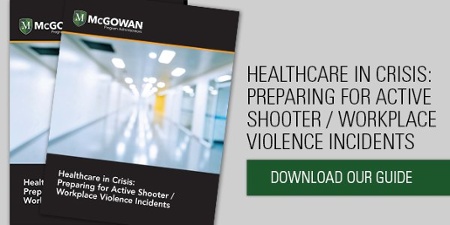During active shooter training, instructors teach several different response plans to equip healthcare employees with the tools necessary to act quickly and decisively during an active shooter incident. Let’s take a look at the challenges and appropriate responses to help protect you and your patients during an event.
Challenges hospitals face with active shooter incidents
The most significant challenge healthcare employees face is the unpredictability and speed at which an active shooter event unfolds. Hospital personnel must be prepared to take action at the outset of an active shooter incident before law enforcement arrives.
The plan must address all vulnerabilities within each healthcare facility and demonstrate how every issue will be solved. Some variables include facility size, location, number of care units, the presence of students, security support, law enforcement availability, and response times.
Along with having a plan, hospital personnel should run through exercises, taking the time to prepare mentally by asking:
- How would I react?
- Where would I go if I’m in a specific location in the hospital?
- How will I help those around me?
Active shooter response plans
As an active shooter incident unfolds, what are the responsibilities of the employees in the facility? An effective response plan details how staff members will ideally react once an active shooter event is underway. Let’s review two of the most effective response plans.
Run, hide, fight – active shooter response
- Run — Your first responsibility is to save your own life. You can’t help others if you’re injured or dead. If you have a clear path to evacuate the area safely, you should take it.
- Hide — If you’re unable to evacuate, find a place where you can hide or deny the shooter access to yourself and patients.
- Fight — The last resort tactic used only if your life or the lives of others are at risk. It’s a personal decision, but in certain situations, the only option to survive is to attack and try to incapacitate the shooter.
Avoid-deny-defend
- Avoid — This begins with having situational awareness of your environment before an active event occurs. It also means having a plan in mind about what you would do if an event took place by knowing your escape route. Avoiding danger is the goal here.
- Deny — If avoidance is not possible, finding ways to deny the attacker from accessing you and others around you is the next option. You can close and lock doors, barricade doorways, and do whatever is possible to deny access.
- Defend — This is the last resort and involves taking action. It means defending your life with a physical confrontation if necessary.
There are more variations of these plans with different names, but all touch upon the same themes. When you condition yourself to identify options and take action before an active shooter incident starts, you’re much more likely to react effectively as the event unfolds.
 hbspt.cta.load(49319, ‘981624c9-c4a6-4442-aa58-43ba3a25a300’, {});
hbspt.cta.load(49319, ‘981624c9-c4a6-4442-aa58-43ba3a25a300’, {});
Comprehensive response plans
Along with addressing healthcare employee preparedness, a comprehensive active shooter incident plan will cover several other aspects affecting the organization. Plans should be dynamic and designed to adapt to the unpredictable nature of a shooting event. It should detail the step-by-step process to coordinate with local law enforcement and first responders. And training is critical for the plan’s success and for personnel to respond appropriately to prevent injuries and save lives.
An essential part of every plan is defining the procedures for leadership to take during the aftermath of an active shooter incident. The physical and emotional recovery for all employees, victims, family members, and friends, and witnesses can go on for months or years. Along with medical treatment and counseling, the organization can incur costs for funeral expenses, crisis management teams, monetary settlements for victims, and facility damages. The healthcare organization may also face lawsuits from victims and their families and will have to address public scrutiny and to mitigate damage to its reputation.
Active shooter incident insurance plays a vital role in the organization’s health after the event by covering all the gray areas a standard hospital system insurance policy leaves out. Contact us today if you have any questions.


